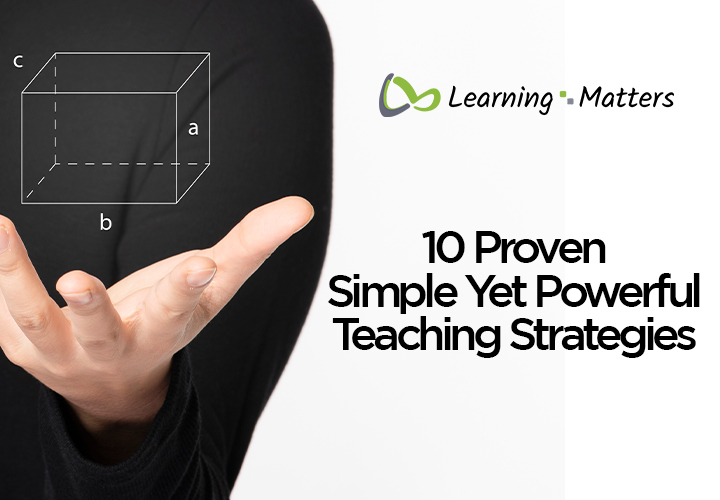Teaching is a noble profession that requires great commitment and dedication to help students learn and grow. It can be challenging but with the right mindset and approach teachers can make a real difference in their students' lives. In this blog, we will explore 10 proven tips that can help any teacher to elevate their teaching, thus making it more effective and engaging for students and ultimately leading to a more positive and successful learning experience for all.
-
Use a variety of teaching methods
Using a variety of teaching methods will help a teacher to know what works and what doesn't for their students. Using different teaching methods will also enable teachers to find out what topics can be taught better through certain teaching styles. Some of the popular teaching methods are:
a) Game-based learning
b) Inquiry-based learning
c) Project-based learning
d) Problem-based learning
e) Collaborative learning
f) Flipped classroom
Read: 7 innovative teaching methods -
Use technology effectively
Incorporating technology into the classroom can seem daunting for educators, but it doesn't have to be. With the appropriate tools, technology can greatly enhance student learning outcomes and make the lives of teachers easier. The right technology can streamline the teaching process, automate repetitive tasks, and provide new ways for students to learn, experiment, and interact.
Read: How is Techology transforming education -
Create a positive classroom environment
The success of a classroom is directly proportional to the positivity in the environment that is created by the teachers along with the students. By fostering a positive and supportive environment, teachers can greatly improve student engagement, behavior, and academic performance, as well as promote a sense of belonging and self-esteem among students.
A few ways to achieve this are:
a) Provide positive feedback to every student
b) Encourage class participation by all through various means
c) Set clear expectations
d) Show enthusiasm and interest in each student
e) Create a welcoming and inclusive environment that allows all students to feel safe
f) Use humor (in appropriate ways)
g) Recognize and celebrate all students’ achievements
h) Encourage collaboration and teamwork
i) Promote a sense of belonging and community -
Foster a growth mindset
Creating a positive atmosphere in the classroom will automatically encourage students to adopt a growth mindset which is critical for achieving long-term success not just in academics but as in all aspects of life. As an educator, it is essential to foster a growth mindset in students, as it creates a healthy competitive atmosphere in the classroom that ultimately benefits the class as a whole. -
Use positive reinforcement
Utilizing positive reinforcement as a teaching method can inspire the desired behaviors in students through the use of appropriate rewards or incentives for positive actions and/or academic achievements. This technique can be employed to encourage class participation, encourage appropriate behavior, and promote academic success. -
Encourage collaboration
Collaborative learning promotes students to aid each other in their learning process and to develop important skills such as communication, problem-solving, and teamwork. It also fosters a sense of teamwork toward achieving common classroom goals which, in turn, can create a sense of belonging among students. It is important for educators to recognize the right type of topics that are suitable for group work in order to foster collaboration and cooperation among students. -
Communicate effectively with students and parents
Knowing how to effectively communicate is a very important skill in educators which can help the students go a long way. Receiving feedback from parents and sharing inputs with them is also important as it helps to set a clear understanding of how the students are performing and can help to identify the areas of challenges for the students.
Read: Effective Communication Strategies for Teachers with Parents -
Set achievable goals
Establishing both short-term and long-term objectives is crucial for a teacher to enable students success. It is essential to set realistic targets, monitor progress consistently and regularly, evaluate, and make adjustments as necessary to the teaching-learning process. -
Continuously reflect on teaching practice
Reflecting on teaching practice is a vital part of an educator's professional development. It enables teachers to evaluate instruction methods, identify strengths and areas for improvement, and make necessary adjustments to improve student learning. Regular self-reflection or collaboration with colleagues can be done through workshops or seeking feedback. -
Incorporate hands-on activities
Practical hands-on activities can be extremely powerful for promoting effective and strong student learning. They provide students with the opportunity to apply their knowledge in real-world situations which can deepen their understanding of the topic and increase retention of learning. Therefore, it is important for educators to make the addition of hands-on activities a priority in their teaching, as it can make learning more effective for students.
Conclusion:
By utilizing the strategies mentioned, you can improve your teaching to a higher level. Believe in yourself and strive to become an effective teacher who can have a positive impact on students. Remember that when students are treated with respect, love, and care, they are more likely to achieve positive results. Good luck!


Comments